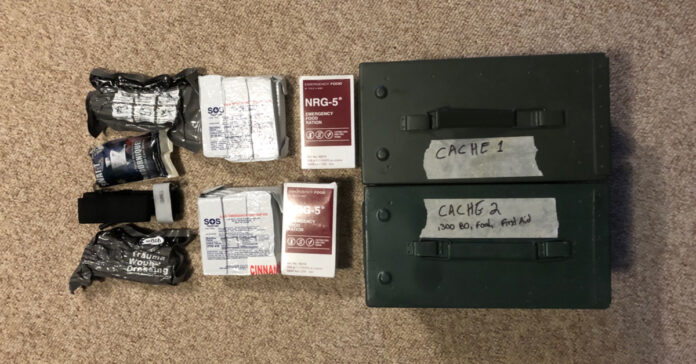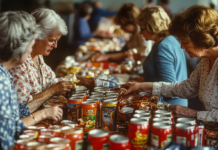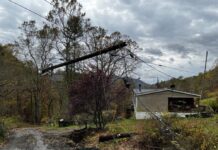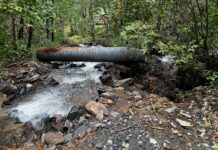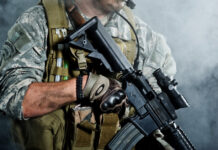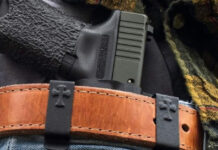I swung by the post office Monday and picked up a couple of packages I’d ordered online to fill in some blanks in my caches and homestead defense bag (HDB). You can see the various medical supplies and emergency food items above. This includes:
- A SWAT-T tourniquet. The best way to describe this is as a wide length stretchy black rubber that you can pull tight above a wound to slow or stop blood loss. I like these because they are quick and easy for almost anyone to use without instructions and can also function as a compression bandage, to make a sling or to hold a length of wood against an injured arm or leg as a splint.
- A knock-off of the CAT Tourniquet. I have an official CAT tourniquet in my EDC bag and in my vehicle first aid kit. This knockoff cost about 75 percent less. Since this is going to live in an ammo can buried somewhere in the woods two miles away from my house, I am OK with it being a knockoff. Chances are low that I ever need it and chances are even lower we will be able to get the victim to a trauma center within a reasonable time frame.
- Two compression bandages. The seller listed these as “Israeli” bandages, but they do not appear to be made in Israel and are likely a Chinese-made knockoff. Had I known, I would not have purchased them. (Yes, this sounds like a double standard, but a tourniquet doesn’t need to be sterile.)
- Two packages of SOS emergency food rations, which I call “lifeboat food” because they are U.S. Coast Guard, approved and can be used on lifeboats. They have a shelf life of five years. I didn’t taste these, but the one I ate in the past had a lemon flavor and had the consistency somewhere between a thick paste and dry dough. Each of the packages is 3,600 calories.
- Two boxes of Katadyn NRG-5 emergency food briquettes. I have never tried these, but I have used Katadyn water filters for more than 20 years and I trust the name. The “compressed high-energy biscuits” are dryer than the SOS food. Each box has 2400 calories and supposedly has a shelf life of 20 years.
Food for the Cache
The latter two items combine to give me 12,000 calories, and that doesn’t count the Cliff Bars, Power Bars, packets of Planters nuts, M&Ms, MREs, some other snack items in my HDB, and a few canned goods. This should be sufficient food to allow one person to operate in the field over a week without getting too hungry. That’s longer than I had expected.
The bars are solid and take up a chunk of space in my ammo cans, but they are not very heavy. The NRG box weighs just over a pound. That’s pretty space-efficient for 2,400 calories. Despite this, I will have to add a second ammo can to my second cache just to hold all the gear.
While I have included many of the items I discussed in my October 23 article, I have left out a mess kit because it takes so much room. A single canteen cup is now included instead. For those of you not familiar, canteen cups slide onto the bottom of your 1-quart canteen and fit into the G.I. Canteen pouch without taking up any additional room and negligible weight. It beats the heck out of boiling water or heating a can of pork and beans in an old WWII metal helmet or an ammo can.
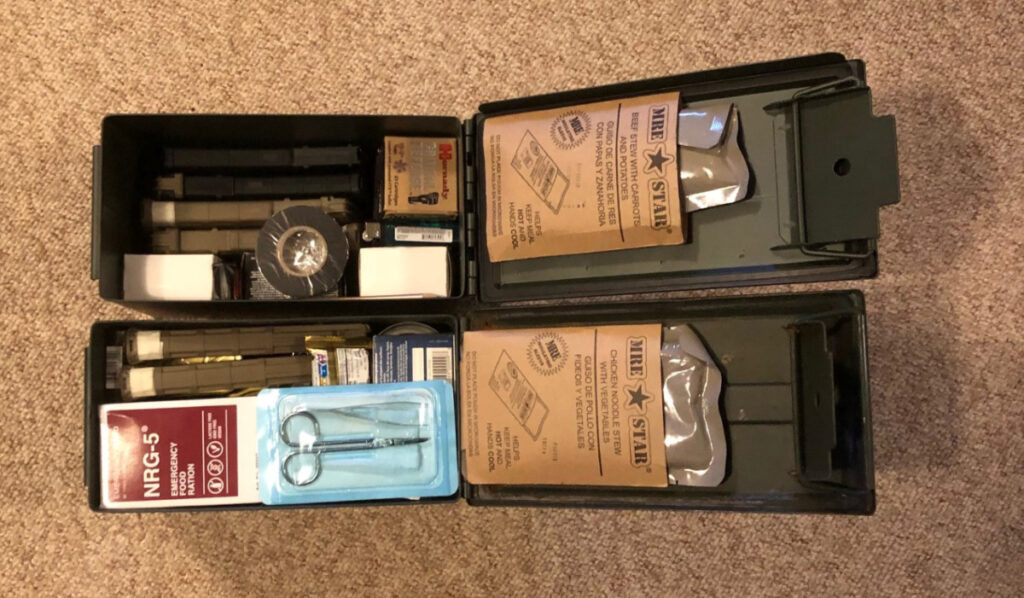
Ammunition and More
Ammo is still the most important part of each cache. In the photo of the open cans, the tan, or flat dark earth, magazines are .300 blackout and the black ones are 5.56. At our house, the ARs in .300BO have tan furniture, all the 5.56 guns have black furniture. The color of the mags match. I intend this to help prevent loading the wrong ammo into a gun. You will also note that all but one magazine has what Magpul calls the “impact dust cover” on the magazine. While this helps keep the ammo clean, the real value is that they press down on the cartridges, keeping the spring pressure off the feed lips. That’s why I use them for a magazine I store loaded for a long duration.
The white boxes in the upper ammo can (Cache One) are surplus .308 rounds. The box under the roll of electrical tape is .38 Special and the small Hornady box is their Civilian Defense rounds in 9mm. Also in the picture is a lighter and a pack of four CR123 batteries. Not pictured are 50 rounds of .22 Stingers and a box of .40 ammo, 10 rounds of 12 gauges 00 buck and 10 foster slugs.
The lower ammo box for Cache Two also contains 90 rounds of .300BO in stripped clips plus a spade for loading magazines straight out of the clips. You can see the tail end of a power bar and a bit of a can of pork and beans. This also includes some first aid supplies, including a tube of antibiotic ointment, sutures, bandages, gauze, medical tape and alcohol wipes. I considered adding a small bottle of betadine, but preferred not to have liquids stored in a can that might freeze.
Multi-Caliber Cache
I designed Cache One as an emergency ammo resupply to cover pretty much any gun I am likely to be carrying, plus a couple I am unlikely to be carrying. If we bolt up the mountain after a firefight in which we use up large quantities of ammo, we visit Cache One. If we’ve just faded into the wood without firing a shot, we leave this untouched, knowing it should be there if we need it in the future.
Cache Two has ammo only for our primary rifles, plus first aid and food. (There will be a second can for this cache with the 5.56 magazines, the canteen cup, some Esbit bricks, and more food. I have decided against an Igloo-style cooler as a cache.) As I said in the prior article, the location of Cache Two is where we can lie low if necessary to rest and recover or if we want to hide between attacks. It is invisible from the air should they have a drone.
Important Combination
It’s important to note that these caches work better when combined with the items in my EDC and my Homestead Defense Bag. For example, none of the ammo would be any use if I wasn’t carrying a gun. The batteries are useless without a flashlight, headlamp, or optic that uses CR123s. The food and first aid supplies may still be valuable, but these are not intended to help us survive on their own.
These caches do not include a water filter or purification tablets; those are is in my HDB. Without it, I’m drinking water from the abundant streams. It is probably clean enough to drink this far into a wilderness area, but maybe not. If not, I’ll find out the hard way a couple of days later.
More Caches?
I haven’t even buried these yet, so it is premature to talk about future caches. I am waiting for our water lines to be buried and for any third parties to be out of the woods and off our property before I head up there and disturb the soil. In fact, I may wait until the end of deer season before I bury them, although this might mean the ground has frozen. Our land is posted, but that doesn’t mean hunters will obey the rules, and if someone were to chase a wounded deer onto our land, I would not stop them.
I have enjoyed putting these caches together. I also like the idea of having some supplies stashed away from the house. While I think every cache will have at least some ammo in it, if I do a third one, it’s going to be focused on food and shelter. At the very least, I may visit Coleman’s Surplus to see if they still sell the GI ponchos and woobies because they would make a valuable addition. Meanwhile, I’ll have some fun scouting the area finding a potential location.

